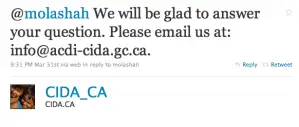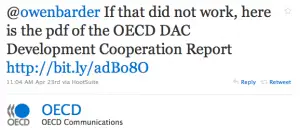Twitter analysis: Development organizations and their listening skills
Everybody wants to be on Twitter and development organizations are no exception. But what do they really want to gain from Twitter? Do they really want to use Twitter to interact through a two-way conversation with their audience? I was curious, so I did a small analysis.

I have chosen ten Twitter accounts from well known development organizations to check their listening and interaction skills. I simply counted and analyzed their replies and retweets of the last 50 tweets. Unfortunatelly couldn't find the time to check the amount of requests sent to the organizations. For sure, for a more representative analysis, more organizations and more indicators would be helpful. Volunteers are welcome!
However, the results are anyway quite clear: There is practicaly no interaction. Twitter is used by development organizations as a purely broadcast channel.
Most make great use of retweets, which are often from affiliated organizations such as in the case of the United Nations. So, even when they retweet, these organizations are still not necessarily following what happens in the twitterverse. Others use inflationationary hashtags such as UNDP. My favorite is: “Burkina Faso: Support for HIV-positive patients http://ow.ly/1BJ0I #HIV #AIDS #UNDP #UN #BURKINAFASO #AFRICA #ARVs” by UNDP.
The only exception I could find was the OECD and CIDA, which actually responded to people.
So why do such organization use Twitter if they miss the opportunity to engage with their audience? Don't they have sufficient resources or are not ready for an authentic conversation? Or, are only the people behind public relations responsible for the Twitter account?
In any case, the amount of followers says very little if an account is also influential and being heard. For example, check out accounts with huge followers and their retweet rate. Not rarely it is incredibly low. That’s why I checked some of the above Twitter accounts also on Twinfluence, which analysis Twitter accounts through different parameters from social network analysis. The results are complementary with the ones above. The United Nations account with 32.055 followers has an influence of 1%. Development Gateway has 4% and OECD 62%.
So, in conclusion, it looks as if development organizations are still on a journey to develop listening skills. But to be fair, there are more promising examples such as the World Bank’s involvement in their Facebook page.
